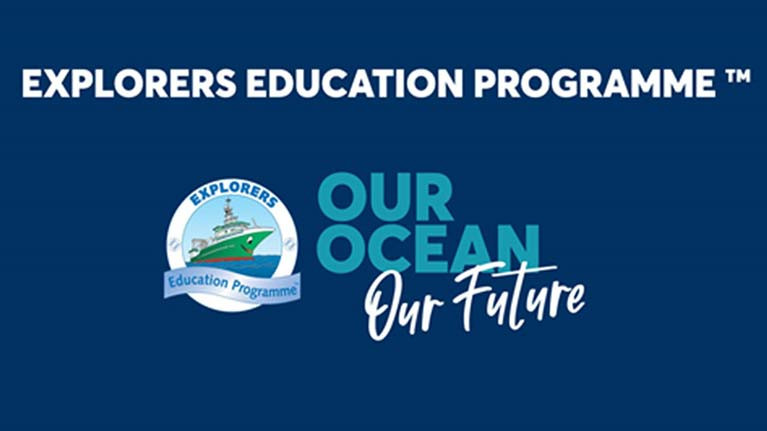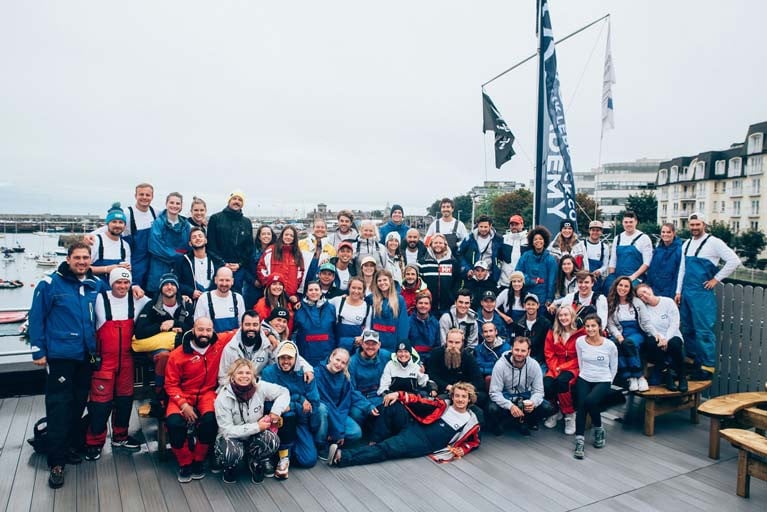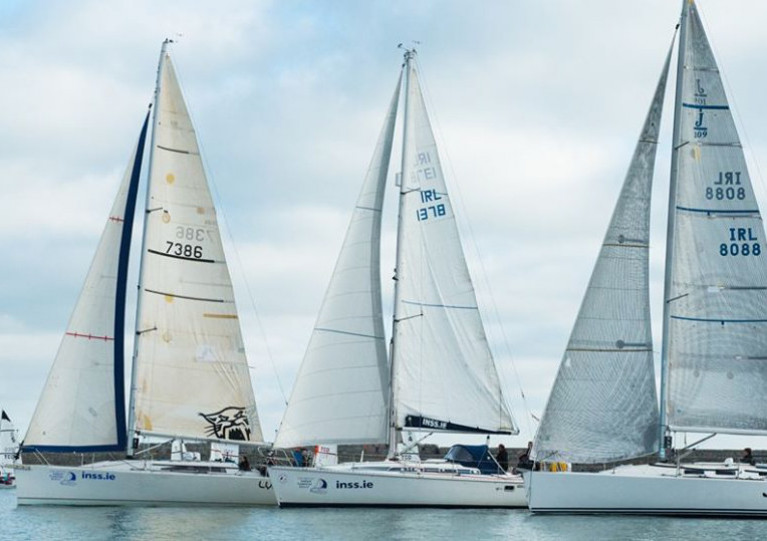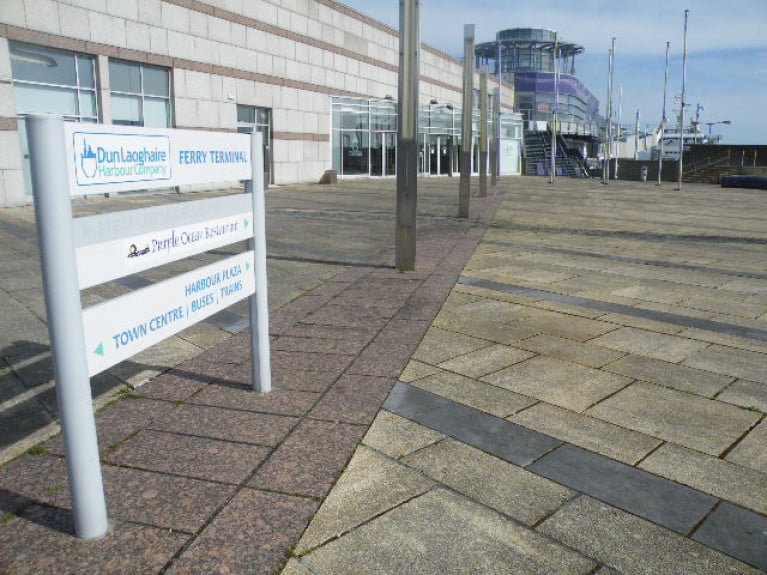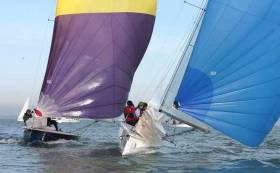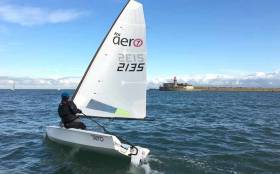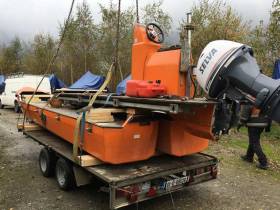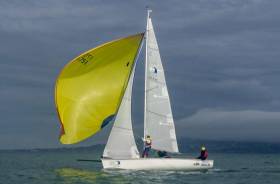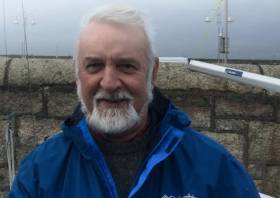Displaying items by tag: INSS
Marine Institute’s 'Explorers Education Programme' Arrives in Dun Laoghaire Harbour
The children from Glenageary Killiney National School (GKNS) are participating in the Marine Institute's Pilot Explorers Education Programme™, hosted by the Irish National Sailing & Powerboat School in Dun Laoghaire this Friday. The programme complements the national school curriculum, presenting children with a deeper understanding of the impact of our ocean, climate change, conservation and a deeper understanding of living things that abound our shores. This programme is a pilot programme funded by the Marine Institute.
‘The children of 5th class in GKNS are delighted and excited to be taking part in this pilot programme, especially this year, as it is very relevant to our attempts to achieve the Green School Biodiversity Flag’ reports Ms Yates, class teacher of fifth class.
The children will participate in a sea safari on the beaches of Salthill and Sea Point in Dun Laoghaire examining marine life and studying the conservation aspects of the shoreline. They will discuss and debate ocean literacy and plan individual and group projects on their findings.
Fifth class hope to participate in The Marine Institute's Explorers Super Hero Pop Art & Creative Writing Competition which was launched by the Marine Institute on the 27 January and is open to all primary schools.
Quarterdeck & INSS Partner to Support Irish Sailors Aiming to Join the Marine Industry
The Irish National Sailing & Powerboat School have just teamed up with Quarterdeck & The Yacht Week to provide Irish sailors with a gateway to become skippers and hosts and enter the world of working in the yacht charter industry.
What is Quarterdeck?
Quarterdeck is the recruitment agency for skippers and hosts worldwide. They provide a tailored Academy that polishes your current skills in order to work with their exclusive partner The Yacht Week along with several other private charter partners in destinations such as Croatia, Greece, Montenegro, British Virgin Islands and many more.
What is The Yacht Week?
“The Best Job In The World!” The Yacht Week is known as a flotilla festival, where skippers and hosts can develop their charter skills while working in a friendly environment, with a community that is there to support and help them grow.
Take it to the next level and spend a summer working at The Yacht Week. Meet friends from all over the world and be part of a truly international team. Skipper for a crew of 10 on a yacht in Croatia, Greece or Montenegro, while being a part of The Yacht Week flotilla of up to 100 yachts per week. Make lasting friendships with people from all over the world and get paid to do it. Whether you are looking to work for a couple of weeks or the entire summer, Quarterdeck wants you!
As a skipper or host for QD you are working on yachts with 6-10 guests onboard. The skipper and host are tasked with making the week exceptional for their guests while keeping them safe.
How does it work?
- Apply for Quarterdeck academy
- Get the required licences. As a partner school of Quarterdeck, the INSS is a recommended choice. The instructors are familiar with the Quarterdeck’s training programme so are the best suited for preparing you for the academy.
- Attend the weeklong Quarterdeck Academy (five weeks to choose from in April or May).
- After passing the academy, Irish sailors are officially part of the team and can now work for The Yacht Week (June, July, August).
Skipper Requirements?
- Recognised skipper licence (ideally RYA Yachtmaster)
- VHF licence
- First Aid Certificate
- A love for sailing
Questions?
Getting an RYA Licence
Contact the Irish National Sailing & Powerboat School by email [email protected] or call 01 2844195.
Joining Quarterdeck Academy
The Academy applications are now open for Spring of 2020. Interested sailors should email [email protected] for any queries.
Special February Deals On Courses With The Irish National Sailing & Powerboat School
The Irish National Sailing & Powerboat School in Dun Laoghaire is running a number of special offers for its February courses — but act fast as places are limited.
The week-long Competent Crew or Day Skipper programme runs from Monday 3 to Friday 7 February, with a reduced price for the last few places from €725 to €449.
An extra course in advance of the schedule start of this year’s Coastal Skipper courses runs from Monday 10 to Friday 14 February for a weekday adventure around the East Coast while learning advanced skipper techniques. The price for this course has dropped from €769 to just €499.
And as of this weekend, only one place remains on the Competent Crew course that pairs with the aforementioned Coastal Skipper course — meaning greater distance covered and places explored. The course fee for this reduced from €725 to €449.
Once these last few places are booked, they’re gone — so book immediately to avoid disappointment.
Bookings for this programme can be made to 01 2844195. Terms and conditions apply, and the INSS cancellation policy can be found HERE.
Sailing School Shows Support For Dun Laoghaire Harbour Food Court Plans
Proposals for a ‘food court’ at Dun Laoghaire Harbour’s currently vacant ferry terminal have been welcomed by one leading local stakeholder.
In a written submission seen by Afloat.ie, Alistair Rumball of the Irish National Sailing & Powerboat School supports the new plans as “the harbour area badly needs year-round footfall, employment, visitors and economic activity, that this change of use both facilitates and drives”.
As reported last month on Afloat.ie, the change is being sought on behalf of Lapetus Investments Ltd to replace the proposed ground floor restaurant and drink vending elements of planning permission approved last year for a mixed-used co-working development at the St Michael’s Pier site.
Rumball adds that, from the standpoint of his more than 40 years of experience in the marine industry, he believes this change of use “will not impinge on the use of berths alongside the former ferry terminal building for commercial vessels, nor restrict a future ferry service”.
The final date for observations on this planning application is this coming Monday 20 January.
Corporate Yacht Racing League for Dublin Bay in 2020
The Irish National Sailing & Powerboat School has launched a corporate racing league on Dublin Bay in 2020.
Racing will take place on Wednesday evenings in 1720s.
How many times have sailors’ colleagues asked, “when are you taking us out sailing?”. This league provides the solution.
A mixed ability crew, lead by a competent skipper, will take charge of a 1720. This benefits for the company involved extend beyond team building and include putting the brand front and centre of a new participation initiative for sailing in Ireland.
Ten identical 1720s are available for crews of 5 from the same company. They’ll be competing against other companies in a series over 5 Wednesday evenings. A training and familiarisation evening will be held on the 29th of April, followed by 4 evenings of competition, running 6th, 13th, 20th, and 27th May.
The après sail will take the form of a meal or BBQ at the Royal Irish Yacht Club. The school is targeting 50 participants. Teams of experienced hands, as well as mixed ability crews, are welcome.
The concept has developed from a visit to Dún Laoghaire by Quarterdeck, the skipper training agency for The Yacht Week last September, where 60 international skippers competed aboard 1720s on the Bay. Combining the on the water action with the shoreside services of Dún Laoghaire’s waterfront will hopefully prove a winning combination. The school produced a short video of the Quarterdeck event, showing what could be on offer for companies this Summer.
A prospectus for interested parties has been prepared here (downloadable below)
Exciting Future for the RS Aero Class in Ireland Predicted
“Momentum behind this innovative and exhilarating dinghy is building in Ireland, and opportunities to engage a wide range of dinghy sailors cannot be overlooked”. Irish RS dealer Kenneth Rumball, is sure in his assessment of what the RS Aero can do for sailing in Ireland.
What makes the Aero such a good fit for the sailor?
The design philosophy for the Aero was to prioritise ultra-light weight, performance and practicality in producing a dinghy for suit sailors between 35 and 100kg. Weighing about the same as an Optimist, and with a variety of rig sizes, you’re sure to have fun afloat, no matter the wind strength. The lightweight design allows for easy transport to and from the water, and even onto the roof of a car, and places the aero as the perfect dinghy for kids, women and men.
The Aero was designed as a hiking boat from the outset. Dun Laoghaire Aero sailors attest to the comfort when sailing – you may not even need hiking pads! This comfort extends to tacks and gybes, with a high boom removing the need to stoop very low when crossing the boat. The Aero has been developed with lessons learnt from previous successful designs, such as improved ergonomics, centre mainsheet system and foils that slot with precision into their cases
Owners will benefit from the unrivalled RS dealer back up and support for spares. Up to 100 shipments leave RS Sailing’s HQ daily, heading all around the world, with excellent freight cost efficiency.
Worldwide numbers of boats are growing rapidly, and event programmes are building quickly, with World Championships being held annually since 2017. While the Aero was not successful at the recent World Sailing Olympic equipment selection process, it did receive the highest score in the One-Person Olympic Equipment Evaluation Report, unanimously considered the best option by the wide range of experts involved. RS Sailing have worked tirelessly to provide an unrivalled international support network for the class, and coupled with the ethos of RS sailing, it would be very foolish to write off the prospects of seeing the Aero one day at the Olympics.
Dynamic three rig system
Key to this broad appeal is the dynamic three rig system. The RS Aero 5, RS Aero 7 and RS Aero 9 rigs cater for a 35-100kg weight range. Using common top sections and booms, but differing bottom sections, these rigs options have been designed with sufficient control to totally flatten and twist the head of the sail upwind reducing the healing moment. This allows a greater sail area to be carried – a big benefit downwind and in lighter conditions. The tracked mast and halyard allow for easy mast stepping, especially in big breeze.
Why the RS Aero is perfect for Dublin Bay
When most of us get to sail there rarely is enough wind to propel foiling boats, and the Aero with is lightweight construction allows for an exhilarating sail in all wind conditions. If foiling takes your fancy, the lightweight full design allows for many non-RS approved, but thoroughly usable, foiling kits available.
With 4 boats now sailing in the DMYC Frostbite Series, the class is growing rapidly. Coupling this with the scheduled RS Aero Irish Open, there never has been a better time to get afloat in an Aero!
The Irish RS Dealer, Irish National Marine Services, is working in conjunction with RS Sailing to offer a special price for the first four additional boats brought into the country. If you’re still not convinced, a demo sail can be organised.
RS Aero Irish Open – 2nd and 3rd May 2020
The RS Aero Irish Open takes place on Saturday 2nd and Sunday 3rd May 2020. The Irish National Sailing & Powerboat School will host the inaugural event from Dun Laoghaire harbour with racing on Dublin Bay.
RS Sailing will support the event with a charter fleet and there is already good interest from RS Aero sailors in both the north and south of the UK. Added to the emerging Irish RS Aero fleet we should be in for a fabulous first event in Ireland!
The early event page is here which shall evolve as more informative and online entry is launched in due course.
Contact:
- Irish National Marine Services: marineservices.ie
- Telephone Kenneth Rumball: 086 407 4275
What are Irish RS Aero owners saying?
Brendan Foley on why he chose the Aero over other options
After racing big boats for 20 years when I wanted to get back into dinghies, I wanted a boat that would be; fun, fast, easy (for a 43 year old!) and challenging enough to push me too. Foiling looked cool but I didn’t fancy flip flopping from wing to wing in light weather. The more traditional single handers of my youth felt a bit dated. The RS Aero was intriguing as you get sailing in all conditions plus the option of foiling. After sailing the boat, I was hooked by the simplicity and the windsurfer like acceleration. The square top main and carbon rig is super responsive, and the lightness of the hull and its shape make hiking bearable! - Brendan
Paul McMahon – RS Aero Owner details what a new sailor can expect from the class
I have been lucky enough to race the RS Aero in four events over the last few years, each time I was able to avail of RS Sailing’s generous charter scheme (their shore side support at the events is also second to none).
My first impressions of the boat were extremely positive. Cockpit layout is well thought out, outhaul and cunningham very close to your forward hand for easy adjustment – and my favourite the water bottle holder at the back!
I remember thinking that it was in effect a modern laser, it’s not! It is a very different boat, one that needs to be sailed to understood. The boat is really rewarding to sail, upwind, it responds well to body movement and sail control. Reaching, it has a bit of get up and go, she planes easily. Downwind, she responds well to changes in angles and gusts – Loads of gains to be made on the runs with good positioning and technique.
After my first sail in the Aero, I was hooked, the purchase decision was made. It took a little longer to persuade my partner – not much to be fair. Racing in the class is very competitive, but there is a good spread of abilities – so wherever you end up in the fleet there will be close racing. The top sailors in the class are extremely generous in sharing their knowledge, so you can quickly get up to speed. This also makes the class a good class for the first steps into dinghy racing.
Peter Barton (probably the fasted Aero sailor about) will often give a detailed introduction to the boat along with go-fast tips – similar to below;
Any of the Aero sailors are happy to help and offer useful bits of advice when needed.
I’m really looking forward to the first real Aero Class racing event in Ireland, without a doubt the boat is going to appeal to dinghy racers in the country. Early interest from the Irish dinghy sailors is strong and it will be a great opportunity to show any travelling U.K boats some Irish hospitality. - Paul
What is the Irish National Sailing School Doing Now?
What is the Irish National Sailing School at Dun Laoghaire Harbour up to now? The answer to that question is: "We're off to film Iceland", School Principal Alistair Rumball told Afloat as his film services division was packed on to trailers this week.
The intrepid Dublin sailing school and film services company have a much sought after marine expertise and that means the INSS crew are often travelling far and wide with plenty of equipment including RIBS, trailers and props such as Viking ships.
Rumball wouldn't be drawn on the name of the next blockbuster, such is the level of confidentiality on these matters, but he did tell Afloat the INSS is heading to Reykjavik on a special assignment.
Rumball has developed a busy marine services division for film and television, with titles such as “Saving Private Ryan”, “Robin Hood”, “PS I Love You” and “The Guard” part of the INSS show reel.
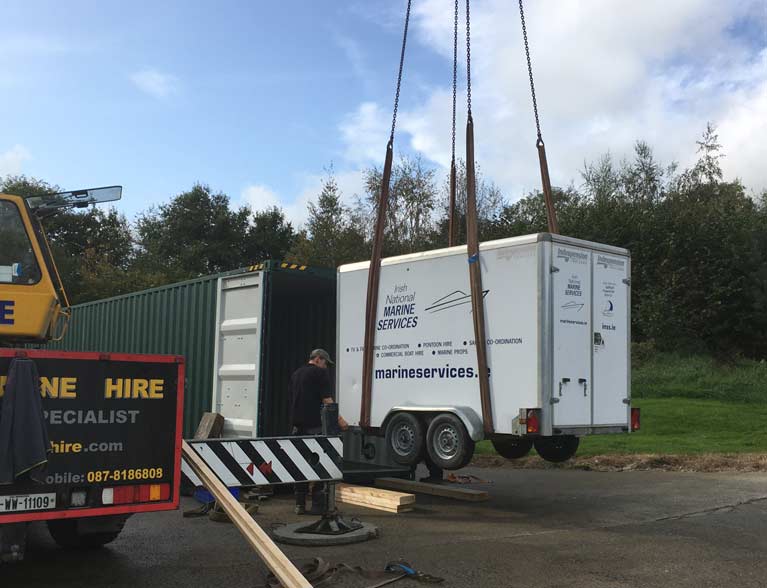 The INSS trailer
The INSS trailer
The largest and most recent project was the TV series “Vikings” filmed in Ireland at locations including Lugala, Loch Dan and off Wicklow head. Alistair not only provides marine co-ordination for up to 200 cast and crew on the water but also organises all the logistics of getting countless craft, including 50ft Viking Ships, onto location.
Check out a few of the videos for a flavour of this work here
Irish National Sailing & Powerboat School Welcomes 60 International Skippers for Weekend of Racing
Last weekend over 60 international skippers and boaters were welcomed to the Irish National Sailing & Powerboat School at Dun Laoghaire Harbour.
The West Pier venue hosted Quarterdeck Academy’s annual Skipper and Host Regatta, which saw close, lively and enjoyable racing from Dun Laoghaire aboard twelve 1720s. Crews comprised people from all over the globe, with the many European countries, the United States, Canada and South Africa particularly well represented.
Racing commenced on Sunday morning and Race Officer Kenneth Rumball got five races in for the day. Racing was facilitated by teamwork from a variety of Dun Laoghaire sailing establishments, with INSS boats, joined by RIYC and RSGYC fleets. This close cooperation happens every week of the Summer months, and it is a testament to all these organisations committed to facilitating participation on the bay.
Check out a video of the racing action…
Monday’s programme was lost to 35-40 knot gusts, however, the international guests more used to Sunnier climes of Croatia, Greece and the British Virgin Island took to the water to experience and Irish Sea South Easterly in the school’s fleet of large passenger RIBs.
Chief Instructor Kenneth Rumball was thrilled to see so many familiar faces, both former instructors in the school now making a living in the marine industry as well as graduates of the school’s yachting courses. “The weekend was particularly rewarding, seeing skills and training put to use. This is what the school is all about, allowing people to live out their boating dreams”.
In total, over 100 Quarterdeck Academy members spent a long weekend in Dublin, with the itinerary including a trip to the Guinness Storehouse on Saturday, Dinner in the CHQ on Sunday evening, and plenty of time to sample the Dublin nightlife too. The draw for all of this tourist group was well organised and fun racing on the ideal training ground of Dublin Bay – drawing over 200 bed nights on the weekend alone. Both why come to Ireland for a weekend, when you can tour the country for the rest of the week? One Irish Skipper turned tour guide, encouraged a large crew to travel the length and breadth of the country seeing all it is Ireland has to offer, after of course, seeing what in the school’s humble opinion is Ireland’s best offering, it's sailing!
The event has served as an excellent trial run for this style of activity, and plans are already afoot to build on the success of the weekend with a similar programme tailored to introducing more people to racing on Dublin Bay.
Outboard Engine Course At INSS Next Saturday
Next Saturday 5 October sees the Irish National Sailing & Powerboat School in Dun Laoghaire host an outboard engine course designed and presented by Brian Hughes.
With 48 years of experience in the industry — most notably and recently with Dalkey outboard engine specialists Killen Marine — Hughes will bring his wealth of knowledge and know-how to the day-long course at the INSS’s West Pier base.
Hughes says: “I feel quite strongly that a lot of boat owners really have very little knowledge about quite simple and basic aspects of their outboard (and to a certain extent inboards) so hopefully this is something I can help rectify … and keep me out of mischief while retired!”
The course fee is €89 and bookings can be made at 01 284 4195. For more visit INSS.ie
The Irish National Sailing School (INSS) is seeking a full-time Instructor and co-ordinator. The successful candidate will also provide coordination assistance for the operation of a busy watersports centre.
Role Description
- Role: Full Time Sailing Instructor / Operations Coordinator
- Duration: 1-year contract starting immediately
- Salary: Based on Experience
- Hours: Wednesday to Sunday from September to May, Monday to Friday from June to August. Some flexibility is required.
- Role Pre-requisites and Training Scope
- Irish Sailing/RYA Dinghy Instructor Certificate
- Irish Sailing/RYA Powerboat Level 2 Certificate
- Applications are also welcome for candidates who hold senior instructor qualifications.
The school is also happy to take on a candidate with a dinghy instructor qualification, who will be mentored by a team of experienced senior instructors with a view to undertaking a senior instructor qualification during the contract.
Additional training in all aspects of boating may be made available with significant potential for advancement in the marine sector.
Applications
All parties with interest should send their CV to [email protected], using the reference "Full Time Sailing Instructor / Operations Coordinator" in the subject title. Interviews will be happening immediately.


























